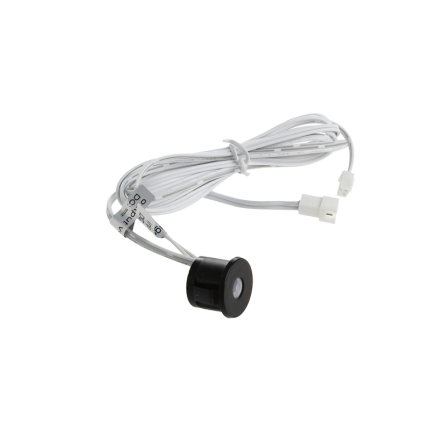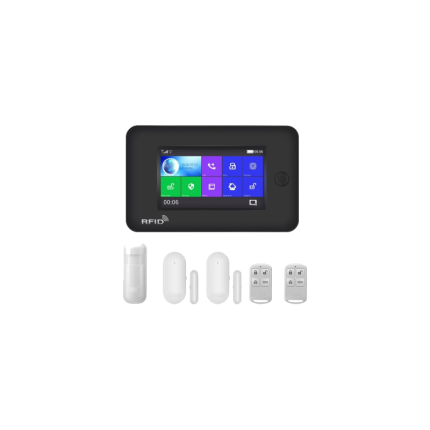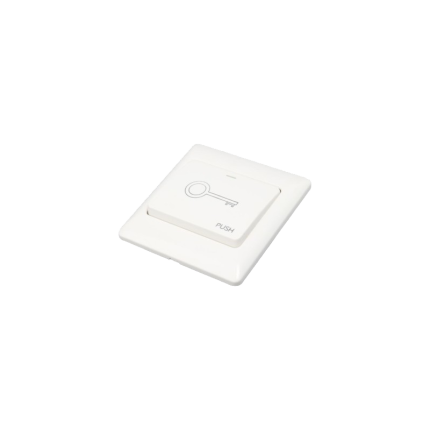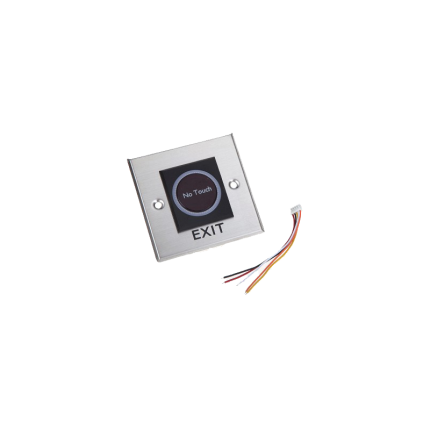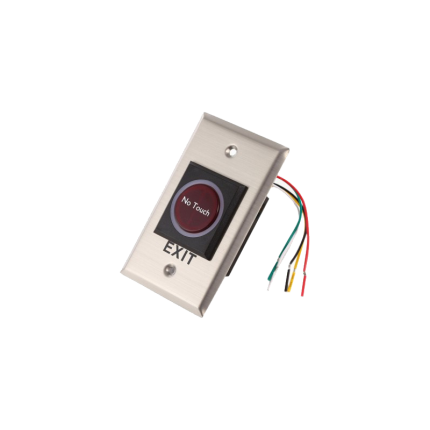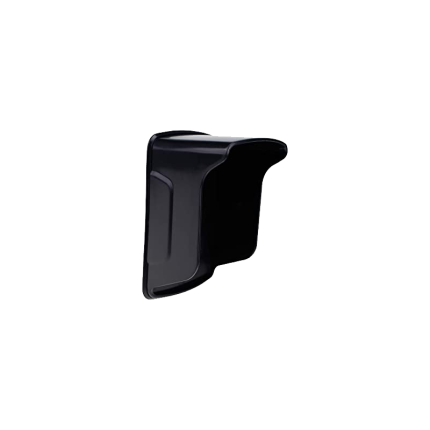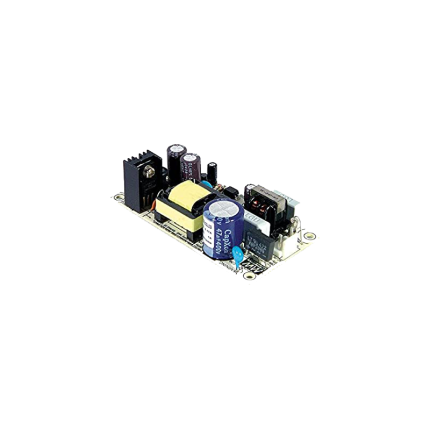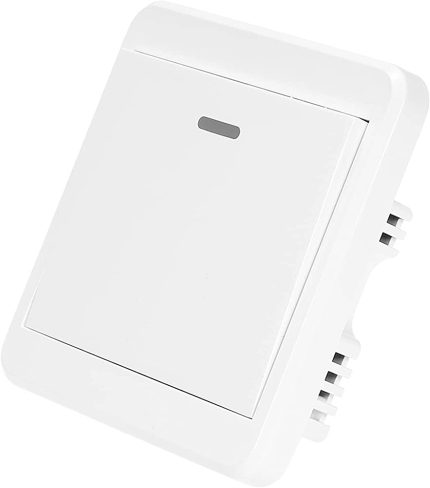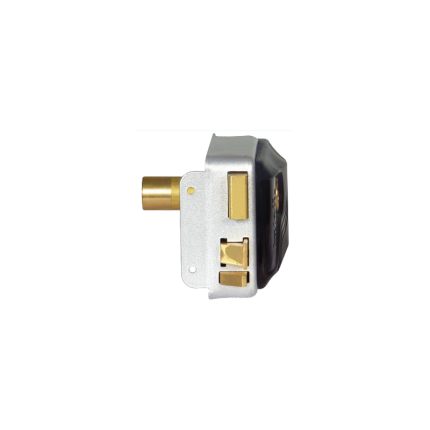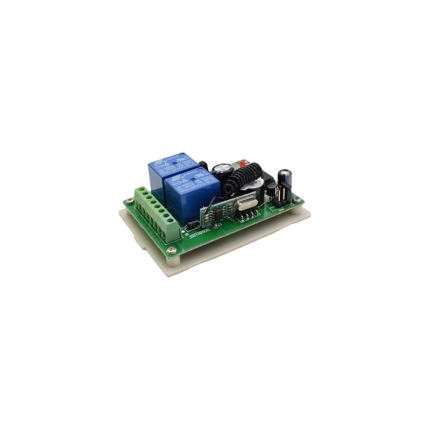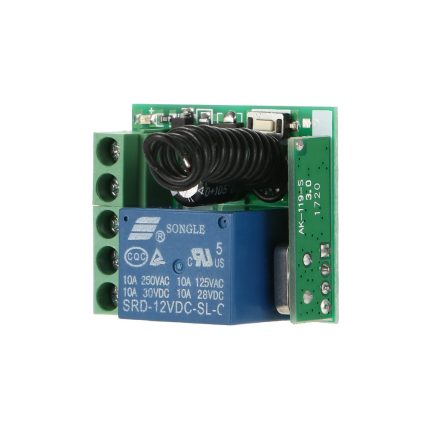Accessories
Infrared PIR Motion Sensor Switch
Ship or pick up from our office.
Infrared PIR Motion Sensor Switch
An Infrared PIR Motion Sensor Switch is an electronic device that detects movement by sensing changes in infrared (IR) radiation in its field of view. "PIR" stands for Passive Infrared, meaning it doesn't emit any energy itself but rather passively monitors the infrared radiation given off by objects. 🌡️ How it Works At the core of a PIR sensor is a pyroelectric sensor, which is sensitive to heat (infrared radiation). Most PIR sensors have two halves, or "slots," wired in a differential arrangement. Here's a simplified breakdown of its operation:- Idle State: When there's no movement, both halves of the sensor detect the same amount of ambient infrared radiation from the surroundings.
- Motion Detection: When a warm object, like a human or animal, moves into the sensor's field of view, it first intercepts one half of the sensor, creating a temporary difference in the infrared radiation detected by the two halves. This difference generates a voltage pulse.
- Signal Processing: The sensor's circuitry processes this voltage pulse. If the change is significant and matches the pattern of a moving heat source, the sensor triggers an output signal.
- Fresnel Lens: A key component of a PIR sensor is the Fresnel lens . This specially designed plastic lens focuses infrared radiation from different angles onto the pyroelectric sensor, effectively dividing the detection area into multiple sensitive zones. This allows the sensor to have a wider field of view and detect movement more effectively.
- Automatic Lighting Control: This is one of the most common applications. PIR sensors turn lights on when someone enters a room, hallway, or outdoor area and turn them off after a set period of no motion, saving energy.
- Security Systems: They are integral to security alarms, detecting intruders and triggering alerts or security cameras.
- Smart Home Systems: PIR sensors play a role in smart homes for automating various functions, from lighting and HVAC systems to controlling appliances based on occupancy.
- Automatic Doors: In public buildings, they detect approaching individuals to automatically open doors.
- Energy Management: By ensuring that lights, HVAC, and other devices only operate when an area is occupied, PIR sensors contribute significantly to energy savings in residential and commercial settings.
- Wildlife Tracking and Research: Researchers use them to monitor animal movements without disturbance.
Home Alarm System – WIFI SX1
Ship or pick up from our office.
Home Alarm System - WIFI SX1
Included: *Wireless/Wired Zones *WiFi network, support APP push/SMS/Voice, such as different alarm channels *Multi-language menu, Touch screen display *2 x ON/Off Remote control *2 x Wireless magnetic sensor *1 x Wireless PIR Infrared Sensor The "Home Alarm System - WIFI SX1" appears to refer to a specific type of DIY-friendly, wireless home security system that leverages both Wi-Fi and 4G connectivity for enhanced reliability. While specific manufacturers might produce variations, the general characteristics of an SX1 system include: Key Features and Functionality:- Wireless and DIY Installation: Designed for easy setup without complex wiring or professional installation, often using double-sided adhesive tape for sensors.
- Wi-Fi and 4G Connectivity: This is a core feature, allowing remote monitoring and control via a smartphone app (e.g., SmartHome Security app, Nexxt Home app, X-Sense Home Security app, or generic Tuya Smart/Smart Life app). The 4G acts as a backup in case of Wi-Fi outages, ensuring continuous protection.
- Battery Backup: A built-in lithium battery (often 3.7V/900mA, providing about 12 hours of backup) ensures the system remains operational during power failures.
- Expandability: These systems are typically expandable, allowing users to add numerous sensors (e.g., up to 50 or 99 sensors and 10 remote controls) to cover various areas of their home or office.
- Variety of Sensors: Common sensors include:
- Door/window contact sensors
- Motion detectors (often pet-immune)
- Smoke and carbon monoxide detectors
- Flood sensors
- Glass break sensors
- Loud Siren: An integrated siren (often around 110-120dB) sounds to alert occupants and deter intruders.
- Real-time Notifications: Users receive instant alerts to their smartphones via the app when an alarm is triggered, a sensor detects activity, or there's a low battery or power loss.
- Customization: The ability to name sensors and remote controls for easier identification.
- Smart Home Integration: Many SX1 systems are compatible with popular smart home platforms like Amazon Alexa, Google Home, and IFTTT, allowing for voice control and integration into broader home automation routines.
- Auto-dialing and SMS Alerts: The system can often be configured to automatically dial pre-programmed numbers and send SMS alerts in case of an alarm.
- Professional Monitoring (Optional): While often a DIY system, some providers or versions might offer optional professional monitoring services for 24/7 security team response.
- Affordability: Often seen as a cost-effective security solution, especially with no mandatory monthly fees (though professional monitoring may incur fees).
- Ease of Use: User-friendly mobile apps and straightforward installation.
- Flexibility: Easily expandable and adaptable to various home or office sizes and security needs.
- Peace of Mind: Home alarm system - WIFI SX1, provides continuous monitoring and alerts, even when away from home.
- Setup Challenges: Some users have reported initial setup difficulties due to unclear instructions or issues with sensor reliability.
- Sensor Reliability: Occasional reports of inconsistent sensor performance or false alarms.
- Wi-Fi Dependency: While 4G provides backup, a stable 2.4 GHz Wi-Fi network is typically required for initial setup and full functionality.
- App Performance: While generally praised, some apps can have occasional freezing or delayed alert issues.
Rain Shield Cover
Ship or pick up from our office.
Rain Shield Cover
Common Applications:
-
Doorbell systems:Protects the doorbell from rain and sun, ensuring it remains functional and visible.
-
Keypad access control systems:Shield the keypad from the elements, preventing malfunctions and ensuring accurate operation.
-
Fingerprint access control systems:Protects the fingerprint sensor from rain and sun exposure, ensuring accurate biometric readings.
-
Standalone RFID door access controllers:Shield the controller from weather elements, ensuring reliable access control.
-
Attendance machines:Protects the machine from rain and sun, ensuring accurate timekeeping records.
Power converters – AC 24 V to DC 15 V
Ship or pick up from our office.
Power converters - AC 24 V to DC 15 V
A "Power converter - AC 24 V to DC 15 V" is a device that transforms an alternating current (AC) input of 24 volts into a direct current (DC) output of 15 volts. Here's a breakdown of what that means and how it works: AC (Alternating Current): This is the type of electricity typically supplied by wall outlets in homes and businesses. The voltage constantly changes direction, flowing back and forth. 24V AC is a common voltage for certain low-voltage control systems, industrial equipment, and sometimes HVAC systems. DC (Direct Current): This is the type of electricity that flows in only one direction. Most electronic devices, like phones, laptops, and many sensors or control circuits, require DC power. How an AC to DC Converter Works: An AC to DC converter (also known as a rectifier or power supply) typically involves several stages:- Step-Down Transformer: The initial 24V AC is usually too high for direct conversion to 15V DC. A transformer "steps down" this AC voltage to a lower, more manageable AC voltage.
- Rectification: This is the core of the AC to DC conversion. Diodes are used to convert the alternating current into a pulsating direct current. There are different types of rectifiers (half-wave, full-wave, bridge) that achieve this with varying degrees of efficiency and ripple.
- Smoothing (Filtering): The pulsating DC output from the rectifier isn't perfectly smooth. Capacitors are used to "smooth out" these ripples, creating a more stable DC voltage.
- Regulation: To ensure a precise and constant 15V DC output, a voltage regulator is often employed. This circuit maintains the output voltage at the desired level, even if the input voltage fluctuates or the load on the power supply changes.
- Industrial control systems: Powering sensors, actuators, and control circuits that operate on 15VDC.
- HVAC systems: Often 24VAC is used for thermostats and control panels, but some components within the system might require 15VDC.
- Security systems: Powering cameras, access control devices, and other equipment.
- Lighting systems: Especially in specialized LED lighting setups.
- Custom electronics projects: Where a stable 15VDC is needed from an existing 24VAC infrastructure.
- Output current (Amps): How much current the connected device needs.
- Power rating (Watts): The total power the converter can deliver.
- Efficiency: How much energy is lost during the conversion process (higher efficiency means less heat and less wasted energy).
- Protection features: Over-voltage, over-current, short-circuit protection for safety and device longevity.
- Form factor: Whether it's an open-frame, enclosed, or DIN-rail mount design.
Power converter – AC 24 V to DC 12 V
Ship or pick up from our office.
Power converter - AC 24 V to DC 12 V
A power converter - AC 24 V to DC 12 V is a device that transforms alternating current (AC) at 24 volts into direct current (DC) at 12 volts. These are also commonly referred to as AC/DC power adapters or rectifiers. How it Works ⚙️ The conversion process from AC to DC typically involves several key stages:- Step-Down Transformer: The 24V AC input first goes through a transformer. This component reduces the voltage from 24V AC to a lower AC voltage, although not necessarily directly to 12V DC at this stage. It's about getting to a more manageable voltage level for the subsequent steps.
- Rectification: The reduced AC voltage then enters a rectifier circuit, usually made of diodes. Diodes allow current to flow in only one direction, effectively converting the alternating current (which periodically reverses direction) into a pulsating direct current (which flows in one direction but isn't smooth).
- Half-wave rectifiers block half of the AC waveform.
- Full-wave rectifiers (like a bridge rectifier) use both halves of the AC waveform, resulting in a smoother, more efficient conversion.
- Smoothing (Filtering): The pulsating DC output from the rectifier isn't perfectly steady. It has "ripples" or fluctuations. To smooth this out, capacitors are used. These components store electrical energy during the peaks of the waveform and release it during the dips, creating a much more stable and continuous DC voltage.
- Voltage Regulation: Finally, a voltage regulator circuit ensures that the output voltage remains consistently at the desired 12V DC, regardless of minor fluctuations in the input AC voltage or changes in the load connected to the converter. This also helps protect the connected device from voltage spikes or drops.
- CCTV cameras and surveillance systems: Many security cameras operate on 12V DC, and these converters allow them to be powered from a 24V AC power supply (which is often used in larger installations for longer cable runs due to less voltage drop).
- Low-voltage lighting: Converting 24V AC to 12V DC for certain LED lights or other low-voltage lighting systems.
- Industrial control systems: Some industrial equipment or sensors might use 12V DC power while the facility's power supply is 24V AC.
- Automotive accessories (with specific input needs): While most car systems are 12V DC, there might be niche applications where a 24V AC source needs to be converted.
- Various electronic projects and devices that require a stable 12V DC supply from an AC input.
Pedestrian gate electric lock
Ship or pick up from our office.
Pedestrian gate electric lock
*DC12 V A pedestrian gate electric lock is a device that uses electrical power to secure a walk-through gate, offering enhanced security and convenience compared to traditional manual locks. These locks are commonly used in residential, commercial, and community settings, often integrated with access control systems. Here's a breakdown of what they are and how they work: How they work:- Electronic Control: The locking mechanism is controlled electronically. This allows it to be locked and unlocked automatically, typically triggered by an access control system.
- Access Control Integration: They can be linked to various access control devices, such as:
- Keypads: Users enter a code to unlock the gate.
- Remote controls: Wireless remotes allow for convenient opening from a distance.
- Intercoms: Visitors can communicate with occupants, who can then grant access.
- Key fobs/Card readers: Users can simply tap or swipe a fob/card to unlock.
- Push buttons: For easy exit from the inside.
- Telephone entry systems: Allowing access via phone.
- Types of Electric Locks:
- Electromechanical Locks: These use an electric impulse to trigger a mechanical latch or bolt to engage or disengage. They are known for their strength and durability, suitable for both indoor and outdoor use.
- Electromagnetic Locks (Maglocks): These consist of an electromagnet mounted on the gate frame and a strike plate on the gate itself. When power is applied, the electromagnet creates a strong magnetic force that holds the gate closed. To unlock, the power to the magnet is simply cut. They offer a high holding force and have no moving parts to wear out.
- Enhanced Security: They provide a higher level of security than manual locks, preventing forced entry and ensuring the gate remains closed, especially in high-wind conditions.
- Automatic Locking/Unlocking: Many models automatically lock when the gate closes and unlock when activated, eliminating the need for manual locking.
- Convenience: Remote operation, keypads, and other access control options make entry and exit much more convenient.
- Versatile Applications: Suitable for a variety of pedestrian gate types (wood, steel, vinyl, etc.) and environments, including driveways, pool areas, playgrounds, and commercial perimeters.
- Fail-Secure vs. Fail-Safe:
- Fail-Secure: The lock remains locked when power is lost. This is common for high-security applications where maintaining security during a power outage is crucial.
- Fail-Safe: The lock unlocks when power is lost. This is often used in safety applications where immediate access is needed during emergencies or power failures.
- Battery Backup: Many systems include a battery backup to ensure continued operation during power outages.
- Manual Override: Most electric locks come with a key for manual release, providing a backup in case of power failure or system malfunction.
- Integration: They can be easily integrated with existing gate openers, timers, and other smart home or security systems.
Radio receiver RG433-24V2C
Ship or pick up from our office.
Radio receiver RG433-24V2C
* DC 24 V * 2 Channels * 433 MHz The RG433-24V2C is a 433 MHz radio receiver primarily used in automated gate systems to control the opening and closing of gates via a remote control. It acts as a crucial component for convenient and secure remote access. Key Features & Specifications 🔑- Frequency: Operates at 433 MHz, a common frequency for remote control applications.
- Channels: The "2C" in its designation suggests it has 2 channels, meaning it can control two different functions or devices.
- Voltage: It typically operates on a DC 24V power supply.
- Application: Primarily designed for gate opener remote control systems.
- Type: It can be an external receiver, often used as a backup or for added functionality in gate automation setups.
- Manufacturer: It's manufactured by Royal Electronics Technology Center Co. (RETCC).
Radio receiver RG433-24V1C
Ship or pick up from our office.
Radio receiver RG433-24V1C
* DC 24 V * 1 Channel * 433 MHz The Radio receiver RG433-24V1C is an electronic device primarily used in automated gate systems. It receives radio signals from a remote control, enabling it to open and close an automatic gate. 🚧 Key Features and Specifications- Frequency: It operates at 433 MHz, a common frequency for remote control applications.
- Voltage: It requires a DC 24V power supply. The "1C" in its name likely refers to its single channel capability, meaning it controls one function (e.g., opening/closing a single gate).
- Function: Its core function is to receive signals, decode commands, and then control the connected gate opener.
- Type: These receivers can be either internal (built into the gate opener unit) or external. External receivers are often used for added functionality or as backup.
- Physical Characteristics: It's a compact device, typically weighing around 0.08 kg with dimensions of approximately 8 × 6 × 3 cm.
- Remote Access: Allowing users to open and close gates wirelessly using a remote control.
- Security: Providing convenient and secure access to properties.
In essence, the RG433-24V1C acts as the "ear" for your automated gate, listening for commands from your remote control to manage access.

